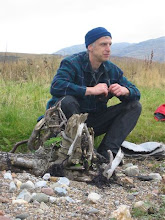
Flanders is a big piece of land, you can see that from the viewing tower and it sits in a big landscape surrounded by hills and mountains but today it was the small things that took my attention. A funny day on the boardwalk, the sun was bright and warm but every so often a cloud would come over and snow flakes would drift down. The warmth of the sun set the little stuff buzzing, everywhere I looked something was purposefully going about their life. In the car park the dandelions were crawling with
hoverflies, bumblebees and honey bees. The
hoverflies with the bee-look-a-like yellow and black stripes would sit tight so that you could get a really close look. Darting
in between all the yellow and black stuff were striking orange-tip and green-veined white butterflies, their names tell you all you need to know to identify them. Along the aggregate path green jewels kept drifting up from my feet. Once they landed a few feet ahead these revealed themselves as green tiger beetles - ferocious predators that run down their prey like cheetahs. Further down the path marched a big hairy
caterpillar, obviously on a mission. I am not great at
caterpillars so am not sure what species this one is but maybe it is a drinker moth, also big and hairy.
But for many people the best site is the Flanders lizards. These common lizards have taken the boardwalk for their own, using it as a perfect basking area. They sit on the side kicking boards and then can dive between the
treads or drop off
the edge if they ever feel threatened. However they seem to be getting used to people as I found I could get very close to them before they darted away.
So a face down mooch along the boardwalk on a sunny day can reveal and wealth of life the everyone can see. Just pick a warmish day.

























